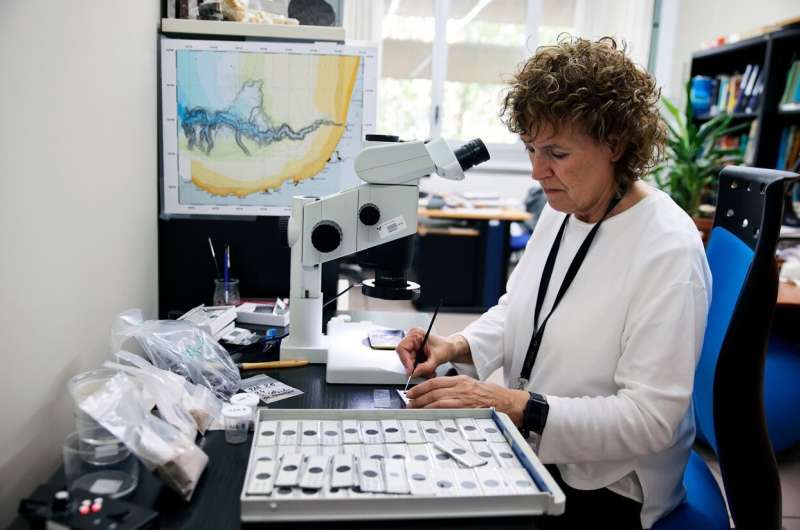This article has been reviewed according to Science X's editorial process and policies. Editors have highlighted the following attributes while ensuring the content's credibility:
fact-checked
trusted source
proofread
Describing various ocean events off the Basque coast by analyzing microscopic organisms

Two groups in the UPV/EHU's Department of Geology have recently each published papers that demonstrate the versatility of analyzing the microfauna present in marine sediments.
One paper provides recent oceanographic information on the Bay of Biscay, while the other has enabled the marine conditions to be inferred at the time when the so-called black Flysch of Armintza was formed (sediments between 113 and 94 million years old). The findings are published in the journal Continental Shelf Research.
The research groups Harea Coastal Geology and Cretaceous and Palaeogene study group, both in the UPV/EHU's Department of Geology, have published two studies in which they extract recent and past oceanographic information (from the Cretaceous period) off the Basque coast based on the analysis of the microfauna present in the sediments.
These two publications are a clear example of the principle of Geology that states that "the present is the key to the past. In other words, we study present-day organisms in depth, and with this information, we extrapolate the conditions that existed in the past by studying the fossil record," explained Ana Pascual, a researcher in the Harea Coastal Geology group and a participant in both studies.
"We have been working on micropalaeontology for nearly 30 years, studying part of the microfauna present in sediments to determine the oceanographic conditions of the past (depth, seabed oxygenation, influence of water masses, etc.). We have always worked with two groups of organisms: ostracoda, very small, often microscopic crustaceans, and benthic foraminifera, a group of protists or single-celled organisms that secrete a shell and live on the seabed," the researcher explained.
They have, however, also studied various present-day oceanic events by analyzing these organisms; according to the conditions prevailing in a location, the composition and distribution of the different species that make up these very large groups of marine organisms varies.
This time, however, they decided to include in their analyses planktonic foraminifera, i.e. those that live in water masses forming part of the plankton and which move with ocean currents.
Dr. Pascual said, "As this was the first time we were working with these foraminifera, our only intention was to get to know the biodiversity, composition and distribution of the species today, and to see if this knowledge about present-day organisms would be useful in making future palaeoclimatic and palaeoceanographic reconstructions." So they analyzed planktonic foraminifera in recent sediment samples they had preserved from a previous study.
The results obtained, however, provided them with additional information: they found that the planktonic foraminifera assemblages "are good indicators of the ocean currents and water masses that reach the Basque continental shelf today," said Pascual. For example, they observed a preferential accumulation of planktonic foraminifera on the eastern margin of the Basque shelf; this accumulation corresponds to the general surface current of the Basque coast and flows eastwards during most of the year. The presence of species typical of both subtropical waters and subpolar zones also indicates the entry of different marine currents into the Bay of Biscay, including upwelling currents (the rise of deep water masses), which are so vital for fishing today.
Reconstruction of the palaeoenvironment of the black flysch of Armintza
As indicated above, knowledge of planktonic and benthic foraminifera and ostracoda has helped these two UPV/EHU geology groups to reconstruct the oceanic environment or conditions that existed when the sediments that gave rise to what we know today as the Armintza black flysch accumulated; that was during the Lower Cretaceous (Albian), which began 113 million years ago as well as during the following stage (Cenomanian) of the Upper Cretaceous, which took place 94 million years ago.
Like all flysch, the Armintza flysch is also a geological formation of sedimentary origin, in which hard layers of rock alternate with layers of softer materials, so that they appear as if they were the pages of a book.
Dr. Pascual pointed out that "the unusual feature of the Armintza flysch is its dark sediment, and Dr. Luis Miguel Agirrezabala of the Cretaceous and Palaeogene study group wanted to determine which conditions had given rise to this characteristic; it is normally associated with environments where there is no oxygen, and where the organic matter that is deposited acquires this dark color."
Based on the high proportion and composition of planktonic and benthic foraminifera, they have estimated that the depth of the sea at that time was about 600 meters. The sediments of the black flysch are rich in organic matter and the vast majority (over 90 %) of the organisms are planktonic foraminifera, "indicating that at the time when these sediments accumulated there was an oxygenated surface water mass on top of a deeper stagnant water mass with very low oxygen levels.
In the next phase, however, an increase in benthic organisms and the appearance of planktonic foraminifera typical of deeper waters was observed, which indicates that the water was no longer stagnant, although there was some oxygen deficiency at the bottom. "This paper provides important information on the formation of the black flysch, since the environmental study of this formation had never been tackled previously," concluded Pascual.
More information: Blanca Martínez-García et al, Distribution of recent planktonic foraminifera in surface sediments of the Basque shelf (S Bay of Biscay): Oceanographic implications, Continental Shelf Research (2023). DOI: 10.1016/j.csr.2023.105011
L.M. Agirrezabala et al, Deep-sea paleoenvironmental evolution in the mid-Cretaceous of the Basque Pyrenees based on microfaunal analysis (Armintza section), Continental Shelf Research (2023). DOI: 10.1016/j.csr.2023.105001
Provided by University of the Basque Country




















